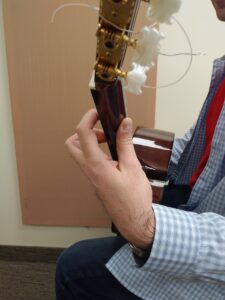
We don’t usually think of playing a musical instrument as a dangerous activity, but like any other repetitive, asymmetrical action, it can lead to injury if not done properly.
Common Injuries
Violin players are commonly affected in the neck, shoulder, elbow and fingers. Flute players often complain of pain in their back, wrist and shoulder. Guitar players, like myself, can develop tendonitis in the shoulder if not taught to hold the instrument correctly.
What To Do
Improving your posture while playing your instrument can help prevent these injuries. Join our teacher, Victor, as he takes you through the steps of proper posture while playing the guitar:
- Sit with your back straight and your shoulders back and parallel.

- Your thumb should be resting on the back of the neck, with your fingers curled around so that the palm of your hand doesn’t touch the neck.
- Your thumb should not curl over the top.
- The top of the body of the guitar should come to your solar plexus or mid-chest level, depending on the size.
- Your shoulder shouldn’t wrap forward around the body of the guitar.
- The crook of your elbow should rest on the edge, and your hand should come in front of the sounding hole.
- The guitar should be straight across in front of you, like you’re “hugging” it. The neck shouldn’t be pushed away from you,

- and the body of the guitar should not be angled out so that you can see what you’re doing!
- The neck should angle up at about 45 degrees. It shouldn’t be pointing out straight, or down at the floor.
We encourage all of our students to develop good posture from the very beginning of their musical journey. As teachers, we want them to have a lifetime of pain-free musical fun.





